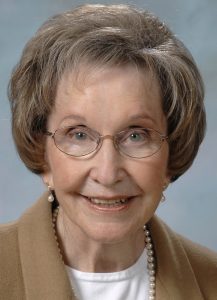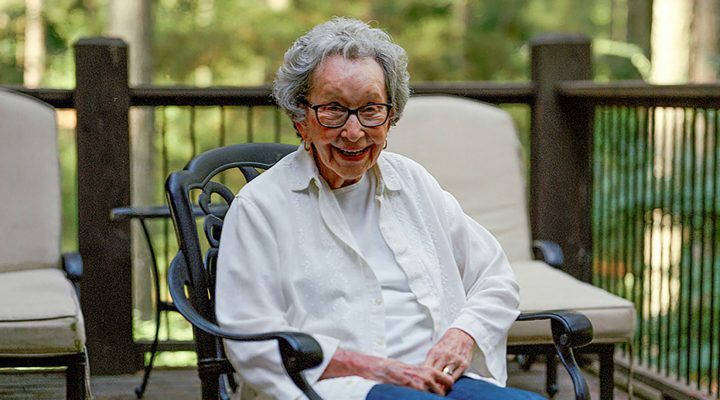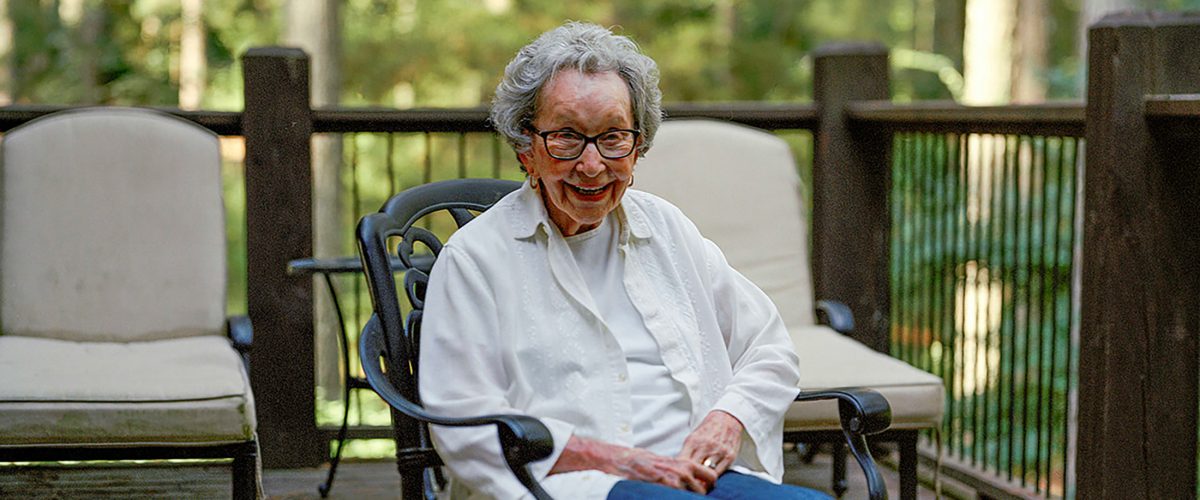Perhaps the greatest moniker Gladys Lewis ever was given was when the comedian Grady Nutt called her “Gladys the Baptist.”
This Oklahoma City woman is not someone most contemporary Southern Baptists and Cooperative Baptists have heard of, but she helped pave a way for women in ministry today, including her own pastor, Sarah Stewart, at First Baptist Church of Oklahoma City. She was an early trailblazer not just for women serving as pastors but for women serving in leadership.
In 1974, she became the first — and at the time the only — female trustee of Southwestern Baptist Theological Seminary, then the world’s largest theological seminary. And in a break with how many local churches still treated women, she was listed in the SBC Annual by her own full name, not her husband’s name with a Mrs. attached.
In 1974, she became the first — and at the time the only — female trustee of Southwestern Baptist Theological Seminary.
It is staggering to think that it took until 1974 for Southwestern Seminary to have even a single female trustee. And in typical fashion, Lewis was more qualified to serve in that capacity than most of the men around her.
Missionaries at heart
She and her husband, Wilbur, had been SBC medical missionaries to Paraguay for two terms. When international politics forced them to return to the States, he set up a surgical practice in Oklahoma City and she later went back to school, earning a master’s degree and a Ph.D. in literature.
He was among the seven founders of the Baptist Medical-Dental Fellowship. That’s a national organization of thousands of health professionals who do short-term mission work. Wilbur realized the need for medical missions but also understood most medical professionals could not give a full four years to serve as appointed missionaries. But giving two weeks of vacation was an easier ask.
Gladys is a woman raised in Southern Baptist life, fluent in missiology, knowledgeable about higher education. And she found herself breaking a glass ceiling at a major seminary just as its denomination stood on the brink of civil war.
She was asked to serve on the SBC Committee on Order of Business the year the “conservative resurgence” began and was invited to be a speaker at summer conferences at Glorieta, N.M. She wrote articles and gave speeches, rubbed shoulders with Southern Baptist leaders who became both her heroes and her nemeses.
She was not technically a “woman in ministry,” but she was a woman doing ministry as a layperson and laying the groundwork for future generations of women to respond to God’s call just as men.
As a professor at the University of Central Oklahoma for 22 years, she took special interest in nurturing her students, who were her own kind of mission field. And as a lay leader, she advocated for a more expansive understanding of God’s call.
An unexpected turn of events
Her original training as a nurse was called into duty when in December 1993 Wilbur suffered a spinal cord injury in a skiing accident that made him suddenly a ventilator-dependent quadriplegic. His particular injury was the same as that suffered by the actor Christopher Reeve.
Thus began a new and unexpected chapter of life as Gladys the Baptist became Gladys the caretaker and Gladys the businesswoman while also continuing her work as Gladys the professor. Wilbur lived another 11 years and died in 2004 at age 74.
“Our lives were shot into another orbit forever as long as we live — an existence of exodus where we live on a plane somewhere between life and death, neither totally one or the other,” she told an Oklahoma Conference on Baptist Women in 2001.
“I am our wage-earner, business manager and linchpin. What nonsense to pose as weak and dependent.”
And in this new reality, the absurdity of the patriarchy taking over the Southern Baptist Convention became more obvious to her, she said. “Coming to grips with the disintegration of my life as the wife of my husband and the shift in my position in my family with my husband’s injury sabotages these ridiculous rules which say I must wait on my husband for direction and authority. My husband is paralyzed and ventilator dependent. I am our wage-earner, business manager and linchpin. What nonsense to pose as weak and dependent.”
This was a new reality but not a new idea of independence. Gladys Lewis was raised as a strong woman in a Southern Baptist church where she took on leadership roles and met people who would become important figures in her later life. She came to faith at Exchange Avenue Baptist Church on the south side of Oklahoma City in a youth revival led by Milton Ferguson, who later became president of Midwestern Baptist Theological Seminary.

Gladys Lewis as a professor at UCO.
After completing a three-year nursing degree at St. Anthony’s School of Nursing in 1953 and passing exams to become a registered nurse, she landed at Oklahoma Baptist University where she served in the student health clinic and got to work on a degree as well. She already knew she was called by God to be a medical missionary, which required a traditional bachelor’s degree.
“That decision gave me experience with another kind of academic life, friends who have remained friends the rest of my life, and a reassurance that I was in the right path for my life,” she said in an OBU article published in 2010.
She married Wilbur in 1955 and they moved to Fort Worth, where in 1955, she finished her baccalaureate degree at Texas Christian University and he did a surgical residency. Then they studied for a year at Southwestern Baptist Theological Seminary before being appointed as medical missionaries to the Baptist Hospital in Asunción, Paraguay.
Aunt Hazel
All that was prelude to becoming the full-fledge Gladys the Baptist who spoke at student conferences and served on denominational committees and boards. When called upon to do that, she was prepared, she said, because of another influential woman in her life, her Aunt Hazel.
Before moving to Oklahoma City, Gladys grew up on a farm in South Central Oklahoma near Wynnewood. Because they lived on a remote farm, her family didn’t go to church at that time. Even then, she said, “I don’t know how else to describe it except that I had a God hunger. I always was drawn toward something I didn’t know.”
Her Aunt Hazel was about 13 years older than Gladys and made her niece her project.
“She taught me the alphabet and she taught me, you put those letters together and you could make words, and words made sentences, and sentences made books. And by the time I started to school, I could read and write. So when I started to school, I was barely 5. There was no kindergarten. I was with the first and second grade in one room.”
Gladys did the first grade work and then the second grade work. That led to her graduating from high school in Oklahoma City at age 16.
When asked to write and speak and be a leader in Baptist matters, she said, “I can do that. Thanks to my Aunt Hazel, I know how to put the pen to the paper.”
A precipitous era
Her entry into national Baptist leadership came at a precipitous time, however. The SBC of Herschel Hobbs, legendary pastor of First Baptist Church of Oklahoma City and chair of the committee that drafted the 1963 Baptist Faith and Message was being challenged by a rightward flank led by men such as Adrian Rogers, the first fundamentalist pastor elected to lead the “conservative resurgence” in 1979.
Around that same time, another Southern Baptist woman from Oklahoma was coming on the scene as a young female pastor and theologian — and a threat to the rising patriarchy in the SBC. That was Molly Marshall, also an OBU graduate, who went on to become a professor of theology at Southern Baptist Theological Seminary. She and others in her orbit became the lightning rods of criticism from the men seeking to take control of the denomination and its seminaries.
Meanwhile, Hobbs’ successor at First Baptist Oklahoma City was Gene Garrison, who not only was Gladys Lewis’ pastor but became a pivotal figure in the moderate Baptist fight against fundamentalism.
Because Oklahoma is such a conservative state, most observers overlook the role a few key Baptists there played in the Baptist Battles of the late 20th century.
“Oh, we fought that thing. We fought that takeover, but we lost.”
When Lewis first arrived on the Southwestern board of trustees, she found a welcoming group of colleagues, she said. “At that time, the trustees at Southwestern were OK. They were my comrades in the trenches. Oh, we fought that thing. We fought that takeover, but we lost. And then on the Committee on Order of Business, I would listen to the conversations and I thought, ‘When all of the fog settles, there’s not going to be a place for me here. They’re not going to welcome women in service positions. And that was obvious. Even then.”
By 2000, when the new leaders of the SBC rewrote the Baptist Faith and Message and made it more oppressive to women, Lewis’ own church studied it and, in her words, “seceded from the union. We decided we couldn’t be a part of what was going on.”
Today, she explains, “in addition to all our other heresies, we have a woman pastor, and she’s absolutely wonderful.”
That’s possible, in part, because Gladys Lewis once was known as Gladys the Baptist — a pioneer among women in lay leadership in the SBC.
Even now, she has a theological explanation for how she believes fundamentalism and complementarianism have misrepresented the Bible. And it comes from her perspective as a professor of literature.
“There was a literary historical development of working away from Eve as the linchpin of all sin because she took the apple and ate it. But when people say that, I say, ‘Well, read the biblical accounts, because Adam was with her when they were out in the garden, and she was smarter than he was because she looked at the apple and said, ‘You want apple pie for dinner, honey?’ And it’s not that she went out there and disobeyed God by herself. They were together. Whatever happened, they were together. The Bible was clear about that.”


